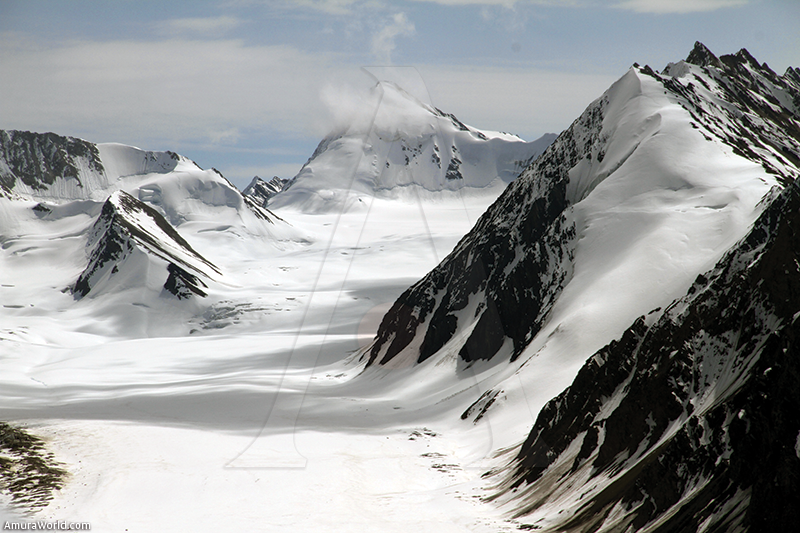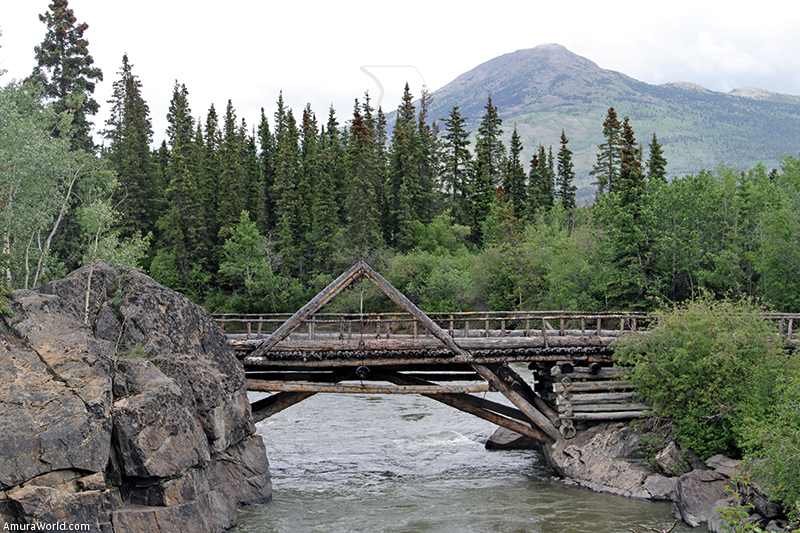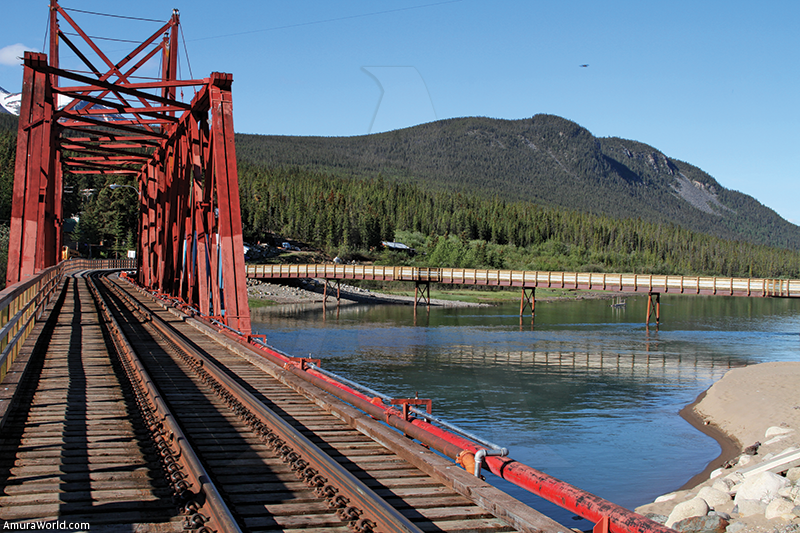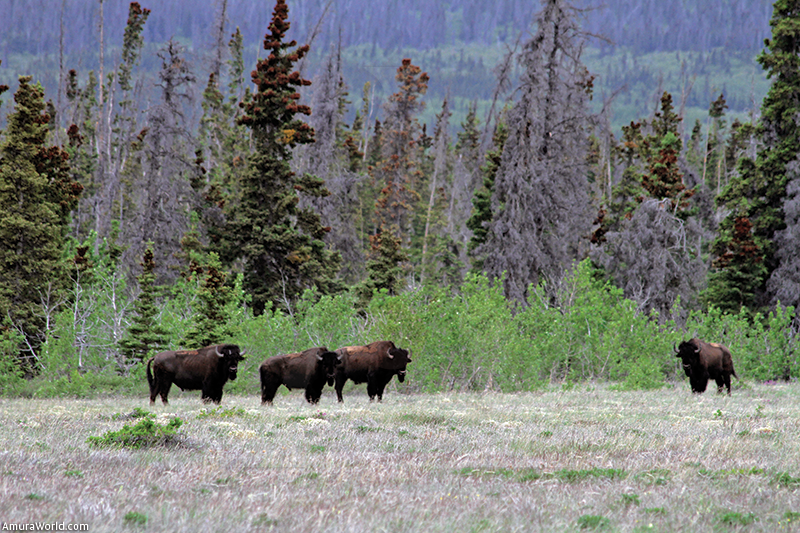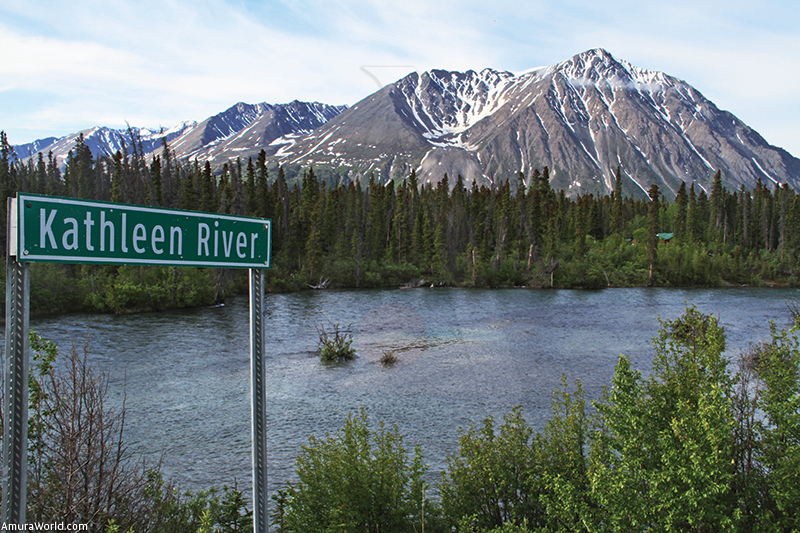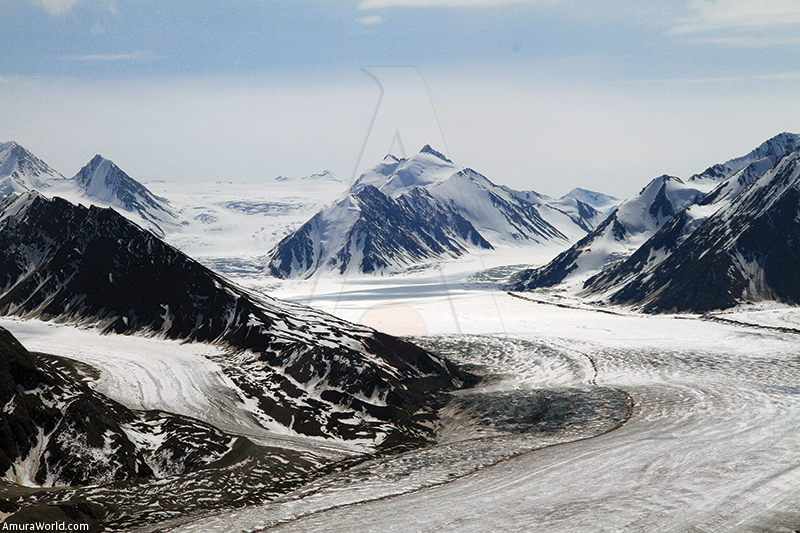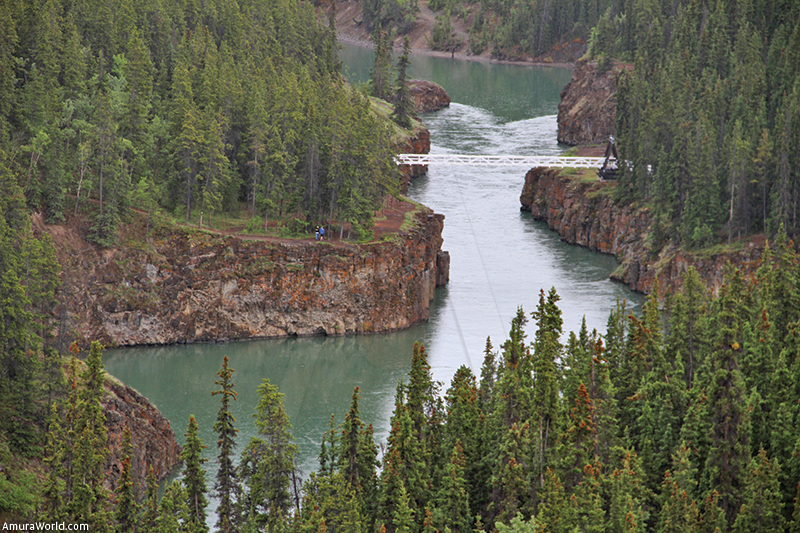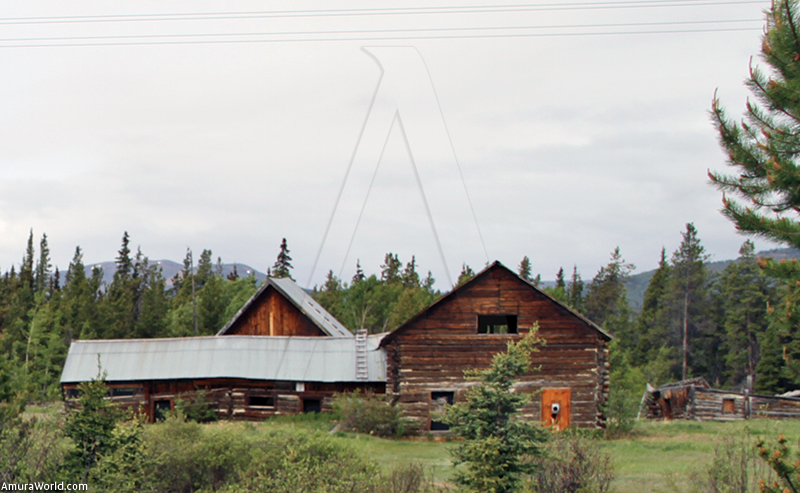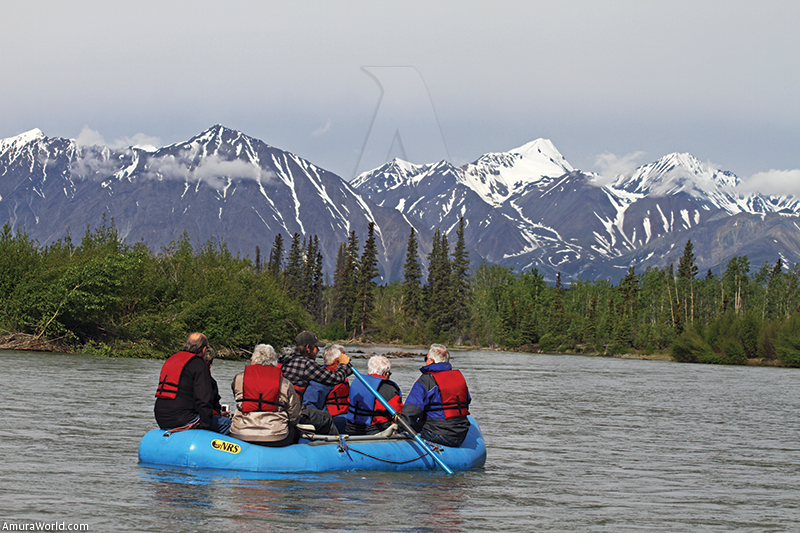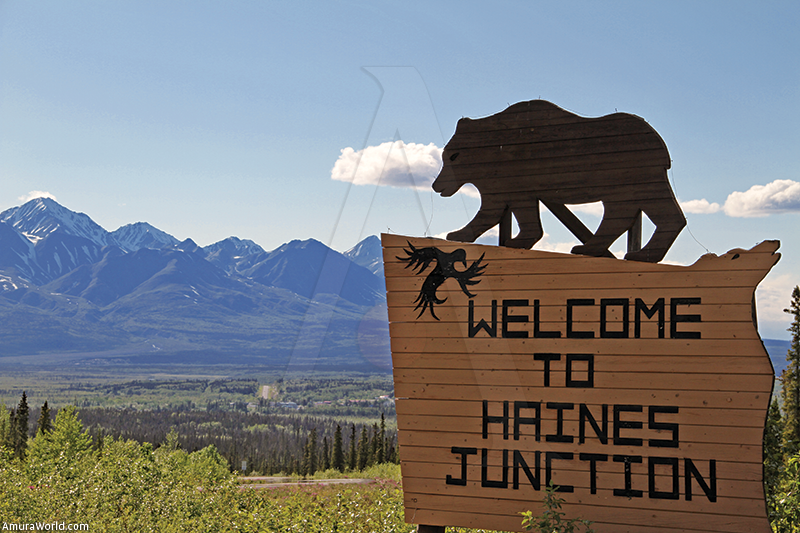The last frontier under the midnight sun
To the north, where days never erase the light in summer and nights are eternal in winter, I found adventure on its pure state, the last frontier of the Gold Rush. Here, the ghosts of the great pioneers glide on the streets of Whitehorse, and the SS Klondike reigns on the edge of the Yukon River, with its elegant wooden silhouette and its large rear wheel as witness of the past. Yukon is a fascinating place where big spaces open on a fire painted horizon in the eternal days, illuminated by a dim light that slips over the bear inhabited mountains, and dazzles with the green aurora borealis of the everlasting nights when bears sleep.
We finished sailing the British Columbia fjords to Prince Rupert Island, and on our way back to Vancouver, I decided to meet Yukon, only two hours and a half on flight. Arriving to Whitehorse, I felt my blood flowing slowly in my body to pacify my mind, relax my muscles and make me a new man that was leaving the city turmoil behind. The world had stopped, the car movement was far behind and the only thing left were the echoes of the Golden Rush that once inhabited that remote place of the Earth.
Outside the airport, I found a bald eagle that ruled the Universe from its nest at the entrance of the city while the SS Klondike watched, from her mooring on the ground, memories of the times when she sailed rivers and lakes, the only nexus with the outside world. Spaces are unlimited, mountains shine with the last traces of snow, the Miles Canyon devours the waters of the Yukon as if trying to absorb the memories of those who defied the rapids when they existed. Today, a dam pacifies the waters. Two streets of a dozen blocks cross the city part from the Main Street where some pubs and a fabulous bookstore offer a lively atmosphere next to the Klondike Ribs & Salmon restaurant, attracting customers. Daylight never fades; sun sets at midnight and comes out at three o’clock in the morning, always leaving a glow in the environment. Visiting Whitehorse streets, I discovered its fabulous murals, the three important pubs, watched people living normal lives at those hours of an nonexistent night, and when I went to the hotel, a shine told me it was time to close my eyes. I felt happy in that unknown world, cold even if it was summer, light and delicate.
Partrige Pass and Frantic Follies
At 6 am I was ready for a walk at the edge of the river while the eagle watched me. Charlie picked me up early and we went to the south, amidst lush snowy mountains and lakes that framed the boreal forest with long, thin trees more than 200 years old. We stopped at Robinson Roadhouse, an ancient commerce post, with cabins built of spruce logs, next to the railway pass linking White Pass to Yukon River, decorated with telegraph poles. Many adventurers came here searching gold and other treasures, in hopes of wealth. The wooden walls and ceilings about to fall echoed the histories of pioneers who went to the last frontier of the Gold Rush of Klondike. Roadhouse was like a hotel where miners rested on their way to Yukon River, and it had a saloon where fun and fights took place. It was a famous place on its time, and his owner, William Robinson, was known as “strong and blunt”.
Leaving the ghost of the past, we entered a dirt road, passing the river that flowed like a stream and where we saw wild goats with long white hair that walked on the high cliffs. We started to climb down an increasingly tough path through the forest to get to Partrige Passage Pass, where we expected to see caribous or bears, but there was no activity. Only the snow reflecting tha clouds that roamed the sky. We kept going up, watching the fabulous scenery, including mountains and high valleys to the limit of vegetation. It was an extraordinary place; the cool breeze ran through my limbs, my cheeks were frozen, but it was worth being in that rugged tundra-covered summit and enjoy the sight of a perfect world.
We finally had to take the way back to get to Whitehorse at the end of the afternoon when the sun was shining. After dinner at Klondike Ribs & Salmon, enjoying its Wild West atmosphere, I went to the theater to see the show “Frantic Follies”, Vaudeville with a taste of 1900 that tells what the pioneers of the great adventure had lived in Klondike. The show has been around for over 30 years, and the theater is filled with visitors, eager of nature and history. When I returned to the hotel, the sun shone on the horizon, and at midnight the sky was painted with an orange wind, sprung from the imagination of a painter.
Fish Lake and Lake Snafu
The next day we went to Lake Snafu, where there were few people. After entering to the water without boat, we sailed through the maze of the lake, watching the bald eagles nesting in the reeds and threw our hooks all day, under an unforgiving sun that warmed us, looking at the beavers building their aquatic dens called Beaver Lodge and achieved to fish eight pikes that we returned to the water. It was just for the glory and fun of fishing. The lake was divine, and it was a wonderful day when we coexisted with nature, and those big fish with black spots.
We returned to Whitehorse at 7 and took my car to reach Fish Lake, which is half an hour of Whitehorse,in the parallel 60o 37‘. A noble landscape expected me, with a lake surrounded by snow-capped mountains whose feet were covered with forest, where ducks swam. Upon arrival, the sun illuminated the peaks and the lake; the high valley we were observing was fabulous and deep in the shadows, where some caribou walked. The horses came up, daring, and arrived to the snowy summit to watch the 11 PM sun that painted the mountains with ocher, playing with them and the clouds. When we got to the lake, the mountains were painted yellow and artificial red and the sun went down on the horizon. It was the famous midnight sun emerging from the stories, bringing light to the north pole and guided us in the tundra. When I arrived to the hotel, the sun had disappeared,but the clarity was still motionless.
Skagway, White Pass y Inn on The Lake
The third day, we took the Alaska Highway, took a turn on Llondike Highway and passed the magnificent Emerald Lake, with its peculiar color coming from a corner of paradise, surrounded by trees, and at the foot of snowy mountains that are reflected in the famous jade colored water of Yukon. We passed by the Spirit Lake, another beauty of that generous nature, before reaching a small sand dune desert that emerged from another world, placed there to remind us that there are also poor and yellow sights in this beautiful green landscape.
We reached the small town of Carcross, with a population of 431 inhabitants, mostly from Tagish First Nation. Some dunes adorned the entrance to the village of buildings taken from western movies, arranged between Bennett and Nares lakes. The atmosphere was of past times, and one could almost hear the ghosts of adventurers treading on the dusty streets and the shots of the disputes between them.
We followed the road which runs along the lake Tutshi where we found our first black bear that was eating the flowers of the field, happy to have so much food and enjoying the sun. We continued to White Pass, reaching a high valley where snow covered the slopes of the mountains and small lakes dotted the plateau.
We left the Canadian border on Fraser and 7 km later, the United States border into Alaska, leaving the top of White Pass at 1000 min height. We visited an impressive suspension bridge over a stormy river. We went down to Skagway, at the end of a beautiful fjord where large cruise ships dock. The village has preserved an air of past times of the Gold Rush, with its wooden houses, boutiques that sell elegant wooden jewelry, and the train station.
After a walk in the village and the marina, I boarded the train to Fraser. The trip was magnificent; we followed the mighty Skagway river that cuts its way through rapids and waterfalls, rocky mountains and a caribou watching the train jiggle to the rhythm of the wheels, from dizzying bridges and mysterious tunnels.
Later, we discovered a grizzly bear that was eating the flowers with its face filled with dandelion seeds, resting in the shade. It was a young animal, majestic and imposing, but delicate. Then, we arrived to Nares Lake to observe ducks; later I found another black bear, and followed the road to reach Lake Marsh where I stayed at the Inn on The Lake.
The sun was on the horizon, the mountains shone in the gray midnight landscape, the birds were singing and enjoying the dim light of the sun that never ends, that everlasting day.
Whitehorse and Takhini River Lodge
Light woke me up at 4 am, and in my interrupted dream I remembered the previous day’s images. I woke up, opening my eyes on the lake that glittered with the diamonds of the horizontal sun, and then I heard the verses of Robert Service in my head: “The happiest man I ever Knew / Lives in a forest glade.”
I enjoyed my breakfast on the sparkling lake and went back to Whitehorse to visit Beringia Interceptive Center, where I admired the fossils of a mammoth, horses and strange animals that inhabited the region long ago. I treated myself to a trip to the past, enjoying the Museum of Transport and imagining the lives of pioneers and adventurers who challenged the great north.
I was thrilled with the old log church that witnessed weddings and funerals. Later, I ate some delicious ribs and visited the ladder for salmon and other fish that migrate to return to the lakes. This Fish ladder is placed aside of the dam and it looks impressive because of the size. The fish climb a waterfall made of wood until they reach a flat channel that leads to Lake Schwatsa and the Yukon River. Then I boarded the MV Schwatsa, a small boat that took me on a dream traveling the Miles Canyon, with walls that enclosed dangerous rapids, challenged by the brave men who went in search of gold.
After a stroll through the streets of Whitehorse, I headed north and discovered the jade colored Takhini River, and went to soak in its hot springs that revitalize the body while breathing the fresh air of the forest. I finally arrived to Takhini River Lodge, a beautiful luxurious house in the countryside surrounded by mountains. I was the owner of the world; mountains and forests were mine and hugged me.
As I was watching the midnight sun from my window, a bald eagle screamed in the distance, another flew over the trees and finally a grizzly emerged from the distant forest to cross the prairie that was submerged in the eternal twilight. The full moon came out of the horizon to caress the mountains, magical and overwhelming, traveling horizontally. “Wilderness and vast are my borders,” as Service had said.
Haines Junction and bears
The next day was my first visit to the Yukon Wildlife Preserve, a haven for the animals of the region where they can live in their natural habitat within a protected reserve. I could closely admire bison, elks, Bura deers, caribous, foxes, Dall sheep, mountain goats with long hair, a beautiful lynx and the strange and rare musk oxen.
Going my way, I stopped to talk to Charlie Muskut, who brings his dog sled and offers winter rides under the sky colored with northern lights that play with artificial colors derived from natural phenomena. And there is no best ride than that of a man who has participated in the Yukon Quest, a dog sled race across 1000 miles between Whitehorse and Fairbanks.
After that, I kept my way in the desolate Alaska Highway that follows the chain of snowy mountains, turning off at them to discover the superb lake Kusawa, which adorns a huge valley in the mountains majestically reflected in its waters.
Following the ridge, I arrived to The Cabin, a place of cottages hidden in the forest, in front of the snowy peaks. I imagined myself as Davy Crockett, the trapper in the woods. I felt the adventure, breathed freedom; I was immersed in nature and felt excited with that scenery . The night never came, and I preferred to explore the area. At 9 I crossed the highway to the south and went through the tiny village of First Nation People, Klukshu, with some wooden huts from where smoke came out. I admired the landscape enclosed by snowy mountains, and found a coyote that, looking for food, finally caught a mouse.
The sky was painted red and at 11 o’clock in the night, along the road, I suddenly discovered 3 grizzlies, a mother with her 2 children. They were beautiful, with beige hair, and resembled teddy bears. They were eating wild flowers and leaves. I could not get tired of watching and admiring them, stunning and impressive, until they disappeared quietly. I would have spent the night watching them. On my way back, I found a beautiful bear with a black shiny coat, which stopped to watch me defiantly.
Ice field
I woke up without knowing the darkness; the light awoke me and I enjoyed that eternal day. After a fabulous breakfast in the woods, I went back to Haines Junction to board a raft and get carried away by the stream of the Dezadeash, and watch the ducks, a moose that grazed at the shore and some swans getting their nests ready. They flew at us like dancers in a ball floating in the air, like an elegant music.
After a walk with superb views of the mountains, we reached the village and went to the small airport to get on Clint’s plane, and flew over one of the largest non-polar ice fields of the world. It was a journey full of strange bodies, curly waves, moving ice, avalanche and huge roads of ice formed centuries ago. The peaks challenged each other in heights; we saw Mount Logan with 5959 meters, the tallest in North America after Mount McKinley (6198 meters), located in Alaska. Glaciers have created some roads that wind through the mountains, drawing a river of ice cracks, and impressive grooves and folds. The view was fabulous and superb in that ice field, which melts to form rivers flowing toward the Pacific.
I took back the Highway to the south in hopes of meeting more bears, but I only found a huge porcupine crossing the road. I discovered the Million Dollar Falls, a beautiful waterfall coming down in a narrow canyon in the middle of the boreal forest, and the road climbs up into British Columbia and reach the icy path surrounded by the snowy peaks of Tatshenshini-Alsek and Kluane.
In my cabin, I was dreaming with the images of that fabulous day, flying over glaciers at the edge of the Earth. On the other side of the Pacific, the hours change and suddenly it’s the next day. Yukon is truly the limit of the world.
Aflek Trail and Kluane Lake
The birds woke me up at 3:30 in the morning, and I continued to dream in the clarity. I got up later to go take a walk to Aflek Trail, a little north of Haines Junction. When we entered the road, we found 6 mountain bison, dark colored, they got scared and fled to the forest. Following our road up, we passed by some rocks and the forest and found a Ptarmigan Willow that was trying to scare us by moving its tail and screaming. We found some strange shapes that were composed by naturally compacted sand balls; a magic trick of the habitat.
We followed the stream that goes down from the snow-capped peaks, and saw jade-like stones, a fabulous landscape and enjoyed that solitude surrounded by the forest, gigantic peaks and streams within the plant and animal kingdom. I had goosebumps and Brent, our guide, explained to us the names of the wonderful flowers that dotted the floor; blue, pink, yellow, white, and how this river flowed into the Dezadeash, which in turn went through the mountains to reach the Pacific.
After this sombre trekking, I went to the north to reach Kluane Lake, which resembled a mirror in that moment, completely motionless. The mountains were reflected on the surface, as if they wanted to look at themselves and confirm their majesty. The afternoon sun lighted the lake and the snowy peaks, which reflected in the water looking more real.
I continued with my active night to arrive to the zone where bears can be found; I took the path to Kluksh village and saw a black bear. It was superb. I walked next to him for a moment and he did not startle. He ate flowers and herbs, and as I was photographing him, my heart was pounding. Although I didn’t have bear repellent with me, I trusted he would never hurt me.
Going forward on the highway, I found a grizzly that hid on the forest and I was very surprised to find yet another one, eating next to a black bear. They looked at each other every once in a while, but they didn’t fight. They ate looking at themselves and at me alternatively, but they were quiet. I stayed in the car and enjoyed that wonderful encounter.
North of Burwash Landing and Kathleen Lake
The sun woke me up as usual, installed on its eternal clarity. After watching the start of the 240 km bike race from Haines Junction to Haines, Alaska, I took the north road again to see the lake Kluane under another sun, under another light but beautiful as ever, and in Sheep Mountain I saw more big horned wild sheep.
I followed the beautiful mountains and the lake to the north until I reached the town of Destruction Bay, a forgotten place in the world. It had that name because of the wreckage caused by a storm in 1940. Finally, I arrived to Burwash Landing, a First Nations town that keeps the Tutchone culture. The signs are written in two languages. I also visited the Kluane Museum of Natural History, where one can enjoy the Tutchone craftsmanship as well as the best examples of the local fauna, stuffed and surrounded by the reconstructed habitat.
In Kathleen Lake, I met with Brent and Ron, a Burwash Landing native and a typical First Nation person, whose ancestors inhabited those lands and some others, came from Europe. He told us stories of his grandparents and of the life as it was on the past, and we went to sail the beautiful, emerald colored lake; we watched a bald eagle on its nest, the green tones of the crystalline water and stopped at a pebble beach to visit a ruined, wooden cabin that belonged to Ron’s grandparents when they went to fish and hunt to the forest. We went up a road amidst an old avalanche to admire the lake, and a bear watched us quietly. The landscape was superb, and we forgot the danger, immersed in the majesty of nature.
I kept going south, the rain started falling and the cold was increasing. I stayed at the Dalton Trail Lodge Hotel on the shores of Lake Dezadeash, a veritable den of fishermen luxury, built of wood in the style of typical Canadian Lodge. The food was delicious; some impressive stuffed fish adorned the walls, men talked about trophies and great fishing histories.
In spite of the weather, I kept going to the south after 9, staying on the highway because the rain made the paths very difficult to travel. Suddenly, I saw an enormous grizzly that walked on the asphalt. It was a formidable, surrealistic image. I followed him for a while until he entered the forest. Soon I discovered another one that walked a little ahead on the woods, happily eating flowers and plants, and finally a huge black bear crossed the road to eat on the edge and disappear into the forest.
Dezadeash Lake and Otter Fall
We boarded a boat early to go fishing to the lake. The cold was rising, the clouds surrounded us and the fish ignored us. Suddenly, when it was freezing, the sun came appeared and a huge trout hooked; it was 60 cm long, and after admiring it, we put it back on the waters, which were 3 or 4 degrees. The day shone, and back to the edge of the lake, I traveled back to Whitehorse, visiting Otter Falls, a beautiful waterfall in a boreal forest.
Whitehorse was our coming back to the civilization after that week on the wilderness, accompanied by snowy peaks and bears, listening to Brent and Ron histories, knowing grizzly’s breath, being about to pet a black bear. I imagined that I was coming back from the edge of the planet, that there was not a place farther away, that I was returning from a time travel. I came back with the experiences that I had with the bears and completed my adventurer life, as the last pioneer of the final frontier.
Yukon is a magical world with bears, glaciers and fascinating people with tramper tales, those who faced the toughest winters to invent history. Yukon is far more splendid than everyone says. I will come back some day to trace the steps of those who were seeking gold in the capital of the Gold Rush, Dawson City and its surroundings. I left with my head full of Robert Service’s verses, the poet of the Gold Rush of Yukon:
Men of the High North, the wild sky is blazing;
Islands of opal float on silver seas;
Swift splendors kindle, barbaric, amazing;
Pale ports of amber, golden argosies.
Text: Patrick Monney ± Photo: Patrick Monney

